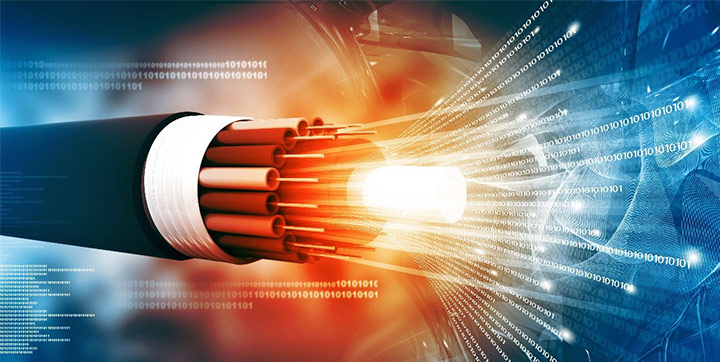Produkte, Lösungen und Services für Unternehmen
Smartphones, PCs & Tablets, Wearables, mobiles Breitband und mehr
Über Huawei, Nachrichten, Veranstaltungen, Brancheneinblicke und mehr
Recently, Huawei officially unveiled its Low-Carbon Intelligent Campus Network Solution tailored to office and commercial building scenarios. As a new addition to Huawei's CloudCampus 3.0, this powerful solution redefines campus switches and reshapes enterprise campus networks through all-new, simplified architecture and unique optical-electrical Power over Ethernet (PoE). The solution enables enterprises around the world to quickly build premium campus networks characterized by their simplicity, lowered carbon emissions, and always-on services.
Reducing Carbon Emissions Is a Shared Global Goal
The year 2020 was one of the three warmest ever recorded, according to State of the Global Climate 2020, a report released by the World Meteorological Organization (WMO). With the need to address climate change becoming increasingly urgent, several countries around the world have already set clear goals to reduce carbon emissions. For example, in September 2020, China announced its "Dual Carbon" goals, which, through a series of stringent policies and measures, aim to reach peak carbon emissions by 2030 and carbon neutrality by 2060. Enterprises, organizations, households, and individuals around the country are coming together to help achieve these goals.
Buildings are the main places where we work, live, and learn. As such, they account for more than 30% of total global energy consumption. For this reason, buildings are a key focus for global energy conservation and emissions reduction efforts, such as those outlined above.
Unlike lights and Air Conditioners (ACs), which can be turned on or off on demand, network devices need to provide buildings with 24/7 network services and must run stably 24 hours a day, 365 days a year. That means that they consume a huge amount of energy. Consider an office building with 2000 users in it. With a traditional network in place, devices across the entire network consume approximately 9.5 kWh of electricity, with annual power consumption climbing as high as 83,000 kW.

New Trends, Fresh Challenges
Now, with the rapid rise of wireless and Internet of Things (IoT) services, traditional three-layer building networks face a range of fresh challenges.
•Reliance on cabling from Extra Low Voltage (ELV) rooms to desktops massively restricts network expansion. A new cable needs to be deployed every time a terminal is added.
•Three-layer networking leads to bandwidth oversubscription, increasing layer by layer. By the time it reaches the user, actual available bandwidth is very low, failing to meet the bandwidth-hungry needs of Wi-Fi 6 APs.
•The rise of IoT is leading to an influx of terminals and stronger demand for access switch ports. As a result, demand for switches is skyrocketing, driving a surge in both initial network construction costs and subsequent Operations and Maintenance (O&M) expenditure.
Inflexible Network Architecture, Costly Capacity Expansion, and Lengthy Deployment Times
Using a traditional cabling approach, an access switch is deployed in an ELV box or room, with one cable routed out from the access switch to each wired terminal. Obviously, the cabling workload increases in parallel with planned user capacity.
To make matters even worse, once a network is planned, deployed, and put into use, it's extremely difficult to expand user capacity due to the cabling workload involved. This results in delayed service provisioning and high capacity expansion costs, failing to support fast terminal access and flexible network expansion.
But is it possible to create more flexible campus network architecture with less cabling and easier, agile capacity expansion?

Insufficient Cable Bandwidth and High CAPEX Due to Frequent Cable Replacements
Different generations of network cables have different bandwidths: for example, Cat5, Cat5E, and Cat6A cables offer 100 Mbit/s, 1000 Mbit/s, and 10 Gbit/s, respectively. With users demanding more and more bandwidth, allied to generational Wi-Fi upgrades, network cables need to be frequently replaced. Put more simply: every new generation of Wi-Fi requires a new generation of cables. Unavoidably, this incurs significant costs.

Note: Cat6 cables support theoretical speeds of 10 Gbit/s, which can only be achieved when transmission distances are within 55 m. Cat6 cables consume more energy than Cat6A cables.
Is there a better transmission medium that enables smooth upgrades with one-off cabling, eliminating the need for frequent replacements?
High TCO, Huge Network CAPEX, and High Energy Consumption
Total Cost of Ownership (TCO), of course, consists of two parts: Capital Expenditure (CAPEX) and Operational Expenditure (OPEX). The former covers the purchase, installation, and deployment costs of devices, cables, and racks, while the latter involves routine O&M costs after network provisioning.
An influx of terminals dramatically increases the demand for ports on access devices, in turn driving up CAPEX. Meanwhile, each device is traditionally managed as one Network Element (NE). As such, as the number of devices increases, so does OPEX. Exacerbating the issue, more devices means higher electricity consumption, placing a strain on the imperative to conserve energy and protect the environment.
Is there an innovative way to slash overall cabling and minimize the energy consumption of devices, aligning with energy conservation and environmental protection goals?

The Solution
Huawei is a long-standing advocate, promoter, and practitioner of green and environmentally-friendly network construction. As such, Huawei continually looks to innovate in terms of product design, production processes, transportation methods, and network deployment. For example, Huawei uses environmentally-friendly packaging, has managed to reduce the energy consumption required for normal product operations, and takes device- and port-level energy conservation measures to reduce network management and operations costs.
Recently, Huawei went a step further, launching its Low-Carbon Intelligent Campus Network Solution. With a host of innovations, this future-proof solution propels enterprise buildings into a green and low-carbon future. Specifically, its all-new and simplified architecture greatly streamlines campus network planning, deployment, and routine O&M, while plug-and-play Remote Units (RUs) slash the number of managed nodes. Energy-efficient chips and a fan-free design provide a blend of quietness and energy saving. In addition, all-new hybrid cables are used in place of traditional copper cables, meeting service demands in the long run and protecting network investment.

One Device, One Network: Simplified Management and Flexible Port Expansion
The all-new simplified architecture consists of a central switch — CloudEngine S-series campus switches — and RUs: the CloudEngine S5731-L-RU series. RUs are deployed on desktops, eliminating any cabling from the access switch in the ELV box or room to terminals.
When a 4-port RU is used, the number of cables required decreases from four to one, slashing the cabling workload by 75%. That figure increases to 87.5% when an 8-port RU is used. And as new terminals are added, they can be easily connected to the nearest RU, supporting flexible expansion.
The full potential of this innovative architecture can now be enjoyed by customers who have deployed Huawei's campus switches on their live networks. In this case, there is no need to deploy new access switches, undertake re-cabling, or expand the port capacity of aggregation switches. Instead, RUs are simply deployed on desktops and connected through existing optical fibers or network cables, quickly expanding the port capacity of access switches. For this to work, note, the software of Huawei's access switches must be upgraded to version R21C10 or later.

Always-On Services, Smooth Network Evolution, and One-Off Cabling
The industry's only optical-electrical PoE technology enables a Power over Ethernet Plus Plus (PoE++) power supply of 60 W, and at ultra-long distances of over 300 m, eliminating the need for an ELV box or cabinet or, indeed, a local mains supply. And as hybrid cables offer ultra-high bandwidth, one-off cabling supports network evolution for the next 15 years.
Using hybrid cables and hybrid modules, the central switch offers ultra-long-distance PoE++ power supply to RUs and Wi-Fi 6 APs. This ensures RUs and APs can be installed whenever and wherever they are needed, freeing Wireless Local Area Network (WLAN) planning and deployment from the constraints of local power supply (such as a power strip) and achieving optimal network coverage. In addition, RUs supply PoE to downstream terminals.
Due to such PoE capabilities, the entire network benefits from a centralized power supply, ensuring that the power supply for offices is independent from the power supply for network devices. This means that, even when the power supply for offices is interrupted, the network is still available, allowing users to enjoy 24/7 network services. For example, RUs enable both data access and PoE power supply for Internet Protocol (IP) cameras and phones, ensuring monitoring and telephony services are available at all times.
Most importantly, hybrid cables offer ultra-high bandwidth for data transmission. This allows network bandwidth to be smoothly upgraded in the future by simply replacing optical modules, with no immediate need to replace cables. Clearly, this fully protects investments made in wired network deployment.

Green, Low-Carbon, and Energy-Efficient Network Construction
RUs require no planning, configuration, nor local management. This greatly reduces the campus network workload and slashes the cost of device management licenses.
If one 48-port access switch is used as the central switch, it can connect downstream to 48 RUs. Assuming these are 8-port RUs, with each supporting eight wired terminals, then one central switch supports 384 wired terminals — 48 x 8 = 384 — equivalent to eight traditional 48-port access switches. As a result, the number of managed nodes is reduced by 87.5%: from eight to just one.
Furthermore, RUs use energy-efficient chips and adopt a fan-free design. Each RU consumes less than 7 W of energy, which is less than 1 W per port, using 30% less energy than the industry average. This is a highly desirable blend of quietness and energy saving.
If a traditional switch is compared to an incandescent lamp, an RU is like an energy-saving Light-Emitting Diode (LED) lamp, consuming less power but providing the same effect. This significantly improves energy efficiency and contributes to energy conservation and emissions reduction efforts.
In an office campus with 2000 users, for example, Huawei's Low-Carbon Intelligent Campus Network Solution delivers very clear benefits.
•38% lower CAPEX, including the procurement and deployment costs of devices, cables, and cabinets.
•30% slashed from electricity expenditure across the entire network, saving 25,193 kW in a year. That's equivalent to not burning 10.1 tonnes of standard coal or planting 1395 new trees.

Uses Out in the Real World
Huawei's Low-Carbon Intelligent Campus Network Solution is a great choice in densely packed rooms, such as administrative offices, hotels, dormitories, and hospital wards. In such scenarios, each room has a relatively small size, with four to eight terminals in use. That's when RUs really come into their own.
This solution is also a good fit in large, standalone buildings, such as airports, stations, exhibition centers, and stadiums. In these venues, hybrid cables — providing both long-distance power supply and high-speed data access — eliminate network cabling and power supply headaches, blending reach and connectivity.
Disclaimer: The views and opinions expressed in this article are those of the author and do not necessarily reflect the official policy, position, products, and technologies of Huawei Technologies Co., Ltd. If you need to learn more about the products and technologies of Huawei Technologies Co., Ltd., please visit our website at e.huawei.com or contact us.